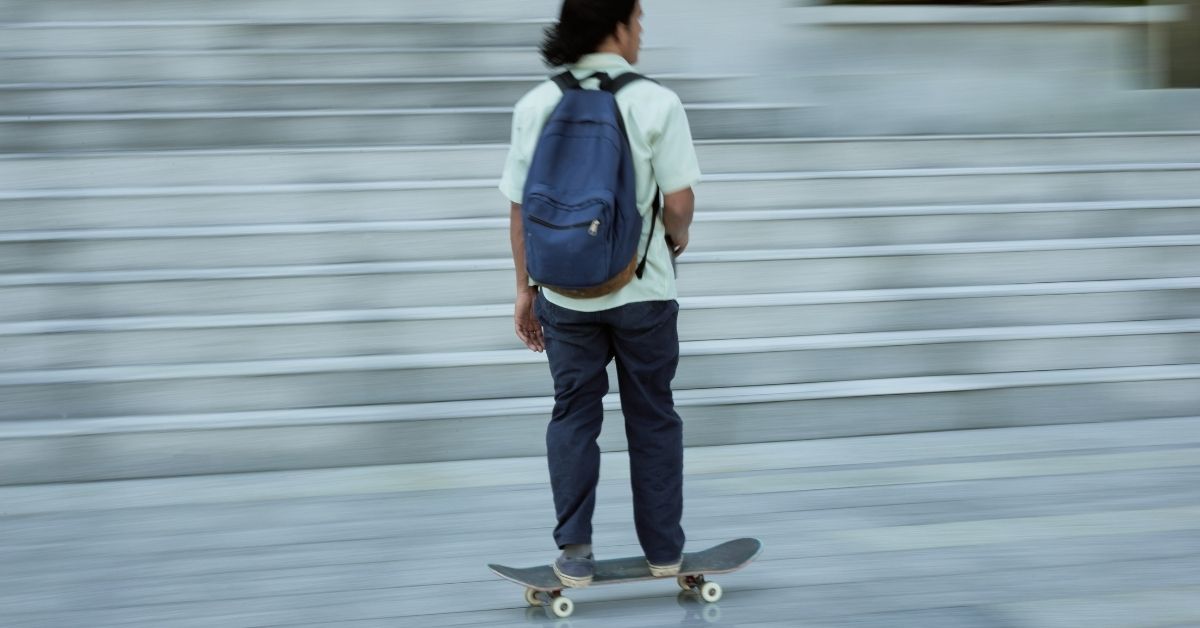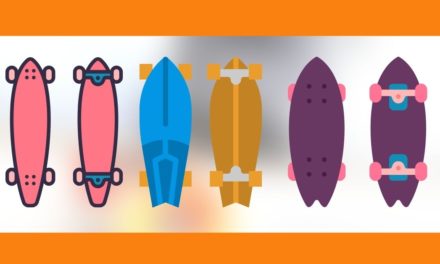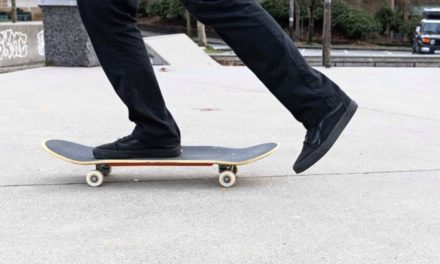If you live in the city or within biking or walking distance from your work, commuting on a skateboard instead is a solid alternative. With some basic experience riding a skateboard, like knowing how to turn and stop, commuting on a skateboard is a ton of fun.
Skateboarding to work is a great idea if you:
- Feel comfortable balancing and avoiding obstacles on a skateboard.
- You commute is under 6 miles or 10km.
- The route to your work is primarily flat.
- It’s dry and sunny during the season you’re currently commuting in.
- You don’t need to carry many heavy items.
- You have a standard level of cardio fitness and leg strength.
- You want a faster way to commute for cheaper than a bike or electic scooter.
As someone who skated to work and school for a number of years, I’m going to break down all the things I loved and the things I didn’t, here in this post. I’ll also pose some questions to ask yourself to see if skateboarding is truly the best method of transportation for you.
First, let’s break down the general pros and cons of getting around town on a skateboard.
The Pros And Cons Of Commuting To Work On A Skateboard
The Advantages
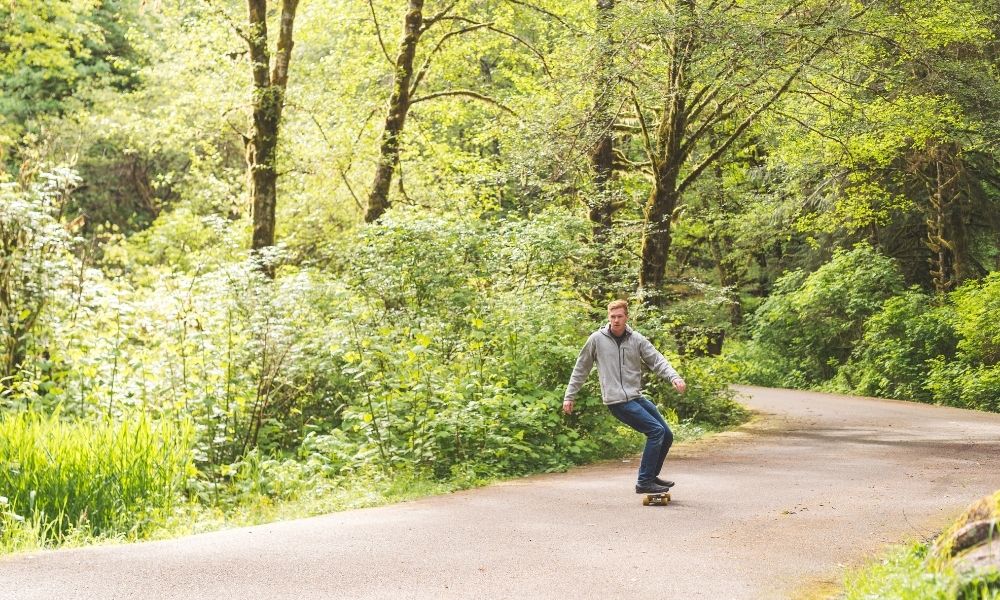
– It’s A LOT Of Fun
The first reason why skateboarding to work is awesome is simply that it’s a ton of fun. Before or after work, carving down a road helped put me in a great mood, even after a rough day. There’s something about cruising down a sidewalk on a sunny day that feels amazing.
Likewise, if you also skate at the skatepark, it’s easy to stop by and have a session after work.
– Skateboards Are Easy To Transport
Some people have to take a bus or train to work, with some walking in between. However, since skateboards are so easy to carry, there’s no hassle if you take other modes of transportation.
Especially if you have a backpack with straps to hold your skateboard, you can easily switch between walking and skateboarding.
Another perk is that there’s no trouble finding a home for your board once you get to work. In smaller offices or for those who work outdoors, finding a home for a bike or scooter is more challenging.
– Skateboards Are Relatively Cheap
Your standard skateboard is much cheaper than other common commuting options like bikes, electric scooters, electric skateboards, and one-wheels. You can pick up a new complete skateboard for under $100, plus buy a softer set of wheels for another $30. For less than $150, skateboarding is a solid option even if you’re on a budget.
– You Don’t Have To Ride On The Road
Many people I know are wary of riding their bikes to work since they have to ride on the side of the road most of the time. You can basically ride along any footpath or sidewalk you want when you skateboard. If you’re worried about being too close to traffic on your ride to work, skateboarding is a solid option to go with again.
The Downsides

– Going Uphill Is Miserable
Unlike other modes of commuting, going uphill on your skateboard only gets harder. This is because each push won’t get you as far, and your legs start to burn even on a small hill.
I have a large hill that I had to skateboard up before it became flat from where I live. Unfortunately, it was way too hard to skateboard up, so I would always walk the hill instead.
So if your commute is varied between hills and flat, remember you won’t be having fun while pushing up any hills. The flats will be awesome, but the hills may make you question your life choices.
Until you can ride back down them, that is.
– Skateboards Aren’t Good In The Rain
Skateboarding is more of a seasonal activity unless you live somewhere that’s always sunny. When you skateboard in the rain, you risk ruining your grip tape, waterlogging your deck, or rusting your bearings. So if you can avoid the rain, it’s always preferable for the lifespan of your deck.
– Rough Roads Or Sidewalks Can Be A Pain

Especially if you’re skating on harder wheels, the vibrations from rough cement or the cracks in the sidewalk can get annoying fast. The vibrations you feel in your feet can make them feel as if they’re asleep, and over a long commute, this isn’t the most enjoyable experience.
Skateboarding probably isn’t the best idea if the only route to or from your work has rough and uneven ground and you don’t have soft wheels.
– Decent Fitness Is Mandatory
Although this isn’t necessarily a “downside,” fitness is a factor that will dictate how much you enjoy commuting to work on a skateboard. Since you have to push, it’s harder to keep momentum on hills, and there’s no easier gear to shift into like on a bike.
Now you don’t need to be in the best shape of your life here. However, a baseline cardio and leg strength level will go a long way to make your commute enjoyable.
What To Consider Before Commuting To Work On A Skateboard
If you’re still on the fence about whether or not riding your skateboard to work is the right move, ask yourself the following questions.
1. How Comfortable Are You On A Skateboard?
If you don’t already feel comfortable with standing, pushing, turning, and stopping on a skateboard, then commuting is not the best idea. Before a day at work, the last thing you want is to take a slam because you felt off balance or couldn’t stop.
Luckily, if you don’t have the skills now, that doesn’t mean you can’t learn them. Practice riding the road in front of your house or take your board to the skatepark on the weekends. Getting comfortable with riding up and down the banks at a skatepark works wonders for your skills and confidence. Within a few weeks of practice, there’s a good chance you’ll feel comfortable skating to work.
Ultimately, you should feel confident enough to stay balanced and comfortable avoiding obstacles before taking a skateboard to work.
2. Is Your Route To Work Flat, Uphill, or Downhill?
Skateboarding might seem like a romantic idea until you have to start pushing uphill. Like I mentioned before, it’s miserable (not to mention extremely slow). If you have to travel uphill to or from work, you may want to consider how much willpower you have before taking your skateboard along.
Skateboarding is an excellent idea if you live somewhere with small rolling hills on your commute or it’s primarily flat. As long as the uphill is tolerable enough to still have a smile on your face when you start skating downhill, that’s what matters.
3. How Rough Are The Roads And Sidewalks You’ll Be Commuting on?
Not all cement is made equal. This is something you’ll become keenly aware of when you start commuting on a skateboard. If the roads you will be skating on are extremely rough, gravelly, or have sidewalks with deep cracks, you’ll need to consider what wheels you plan on riding.
It doesn’t mean you can’t skate when dealing with rough concrete. Instead, you need to get a softer set of wheels to avoid excessive vibrations. I would suggest a 78a durometer wheel for the most comfortable ride, but I share all my favorite wheels for rough roads and cruising in this guide.
4. Do You Have A Skateboard, Penny Board, Or Longboard?
It’s pretty common for people to call any board with four wheels a “skateboard” when, in reality, there are a few different kinds. The most common types of boards people ride and commute with are skateboards, penny boards, and longboards.

A skateboard is categorized as a board that’s 32″ in length and typically has a symmetrical “popsicle” shape. These boards are used for tricks and street skating, but with the right wheels, they can make for a great commuting board. Since this type of deck is comfortable to stand on, reasonably small and portable, and very lightweight, they’re the ideal deck for taking to work.
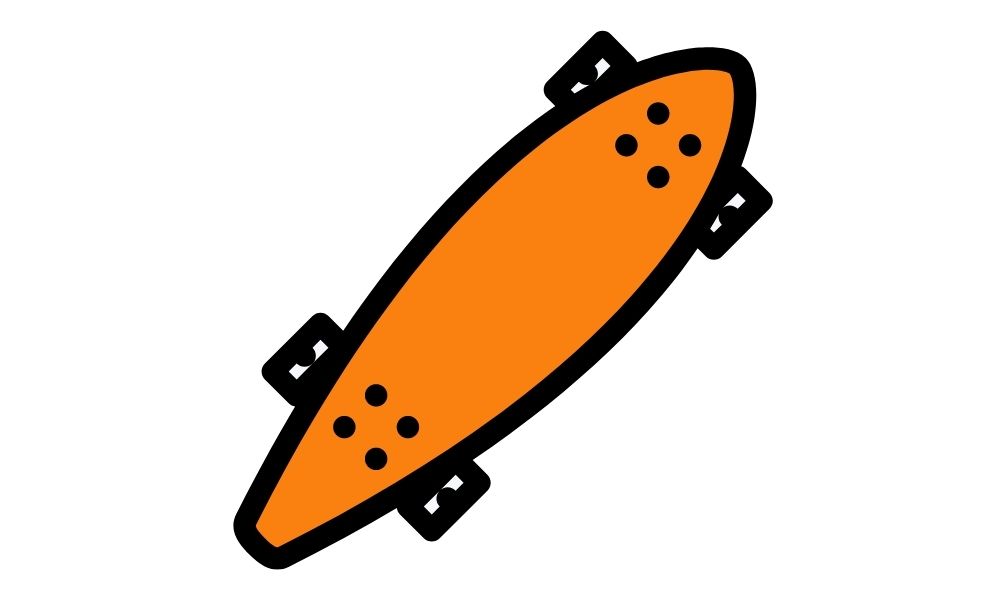
A penny board is 22″ in length and is significantly smaller than a standard skateboard. Although it’s lighter and easier to carry, it’s a bit uncomfortable to ride long distances if you have adult-sized feet. Riding to work on a penny board can get exhausting and a bit awkward, so I would suggest avoiding these for commuting.

Lastly, longboards range in length from 33″ – 59″ and are one of the most comfortable boards to ride on. Since they’re so long, they’re easier to balance on for beginner skaters and feel like a boat to cruise on. They aren’t the best for tight turns, but they are still passable for taking to work. The only downside to a longboard is its size which may be cumbersome if you go between skating and transit on your daily commute.
5. What Bylaws Are In Place For Skateboarding On Sidewalks?
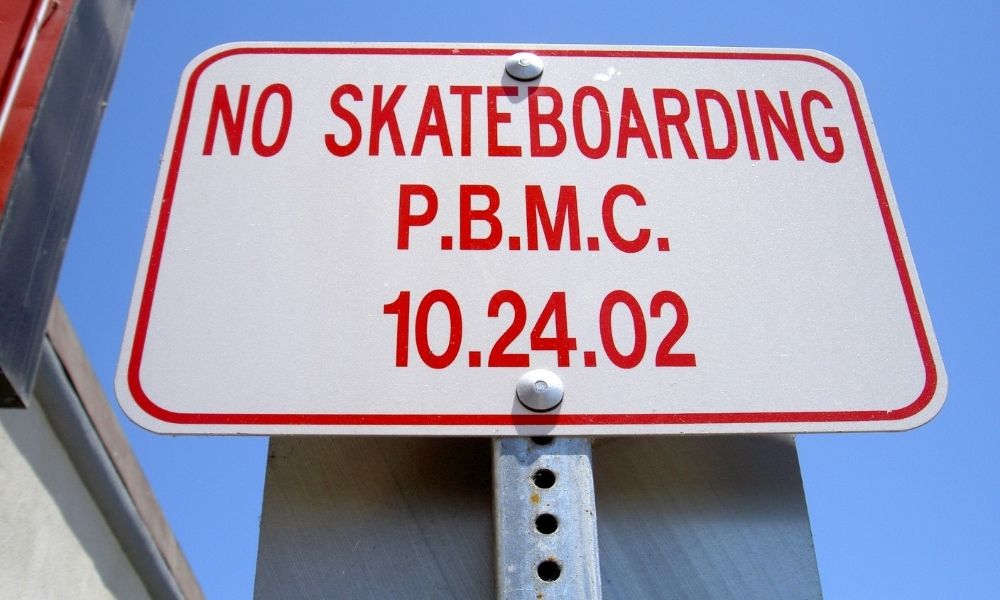
Another thing to consider is the regulations for skateboarding on sidewalks or roadways in your city. For example, where I live in Vancouver, Canada, the bylaw states that skateboarding is only permitted on minor streets, classified as any road without painted lines. If you were in an accident with a pedestrian on the sidewalk or a car while skating on a street with painted lines, you’d technically be at fault.
Every city will have its regulations, so it’s important to look into these before taking your skateboard to work. Although many people opt to ignore these rules, don’t be surprised if you end up with a fine one day.
From my own experiences after skating around the city for years, I’ve never had any significant issues, but it is possible to happen.
6. How Many Things Do You Need To Carry?
The movement of skateboarding forces you to be quite dynamic. Pushing, moving your arms, and bending your legs is a whole lot harder when you have a lot to carry. Skateboarding may not be the best idea if you’re someone who can’t fit everything you need in a backpack.
Even if you can fit everything in a backpack, consider how heavy everything is too. With a big load on your back, your legs will burn out faster, and you might feel blasted before you even get to work. I’d suggest keeping your bag under 25lbs if you plan on skateboarding to work.
Otherwise, a bike may be a better option.
7. How Often Does It Rain Where You Live?

Rain and skateboarding don’t mix. If it rains a lot where you live, skateboarding during the rainy months is something you should avoid. The reason is that getting your skateboard wet reduces the overall lifespan of the board. Your bearings, in particular, will take a huge beating from the wet as they’ll eventually rust and bind up over time. Another issue is water seeping into your deck, which weakens the glue and causes your deck to split and distort.
As someone who lives in a place that rains eight months a year, trust me when I say it’s not worth sacrificing your board for a rainy day commute.
8. How Far Of A Commute Will You Have?
Even if the roads are perfectly smooth, it’s flat the entire way, and it’s always sunny, distance should play a big factor in your decision. As you skateboard more, your stamina will improve, allowing you to go further comfortably. However, a good guideline is to only ride your skateboard if your commute is 6 miles (10km) or less. Anything more than this quickly gets exhausting and starts to take a lot more time than you may have expected.
How Fast Is Skateboarding Compared To Walking?
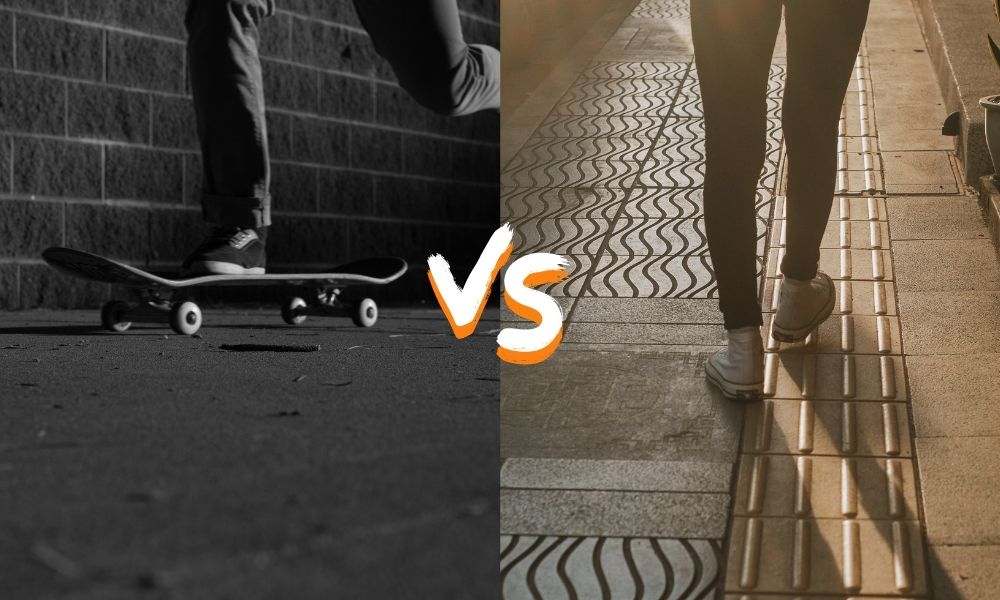
There’s no doubt that skateboarding is a heck of a lot faster than walking, and not to mention more fun. When you consider the average speed of a commuting skater (from an experienced skater on flat ground) is 9mph or 14.4km/h, and the average walking speed is 4mph or 6.4km/h, that means it would take you just 41 minutes to skate 6 miles (10km), while taking 93 minutes walking.
You could theoretically cut your commute time by more than half simply by hopping on your skateboard instead of walking.
Is Skateboarding To Work Harder Than Biking?
As an avid skater, and a biker, there’s no denying that riding a bike is easier in terms of physical ability than a skateboard. Especially when going uphill or trying to go faster, taking a bike is far easier than a skateboard.
With that said, skateboarding has a few major aspects that still make it worthwhile over a bike. A skateboard is much easier to carry, especially if you take trains or transit during your commute. Making space for a bike is a massive inconvenience when a skateboard can easily tuck between your legs wherever you sit.
Another factor is actual storage once you get to work. For example, you may not have an easy place to lock your bike, unlike a skateboard that can be easily tucked away.
So although it is technically easier to ride a bike, taking a skateboard offers some nice convenience factors you wouldn’t get otherwise.
Ultimately, skateboarding to work when the weather is nice is fun and is guaranteed to put you in a great mood. As long as you feel confident riding your skateboard, opting to take it to work is something you should try. Just keep in mind that you may work up a sweat, so bringing a change of clothes to work is worthwhile!
Happy Shredding!
Brendan 🙂

